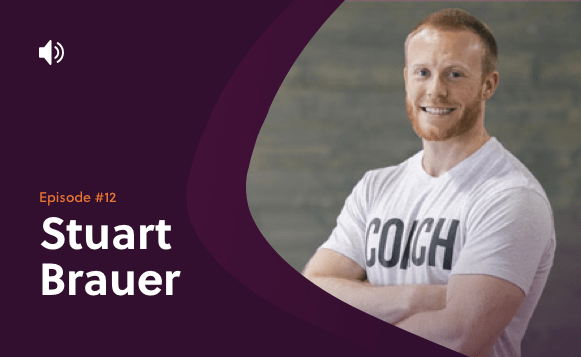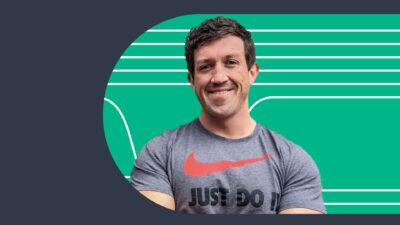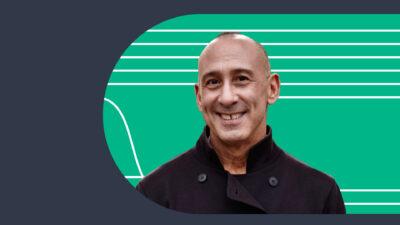Stuart Brauer is a micro gym owner and fitness business consultant who owns and operates WTF Gym Talk, an all-around resource for those looking to grow a real fitness business.
We talk to Stuart about some outside of the box organic lead generation. Stuart believes that great organic marketing is essential to success in the same way paid ads are. Stuart tells us why you need pure, Shakespearean storytelling when it comes to building your brand and why you shouldn’t be intimidated to start influencer marketing.
Subscribe Where You Get Your Podcasts
Transcript
Stuart: The one thing I would recommend everyone is to realize that it takes a long time to re-establish yourself and reinvent yourself. And the only thing that pushes it to go faster or even to happen at all is consistently telling your story in the form of video, audio and image.
Kevin: How is it going everyone! Welcome to the Fitness Founders podcast. I’m Kevin Mannion, VP Marketing here at Glofox. This week I chat to Stuart Brauer. He is a micro gym owner, consultant and the brain of WTF Gym Talk. In this episode, Stuart talks about organic marketing, how to build a network of local influencers and how to clearly tell the story behind your brand. Let’s kick off.
Okay Stuart, welcome to the show.
Stuart: Thank you brother for having me.
Kevin: Thank you for being here. Maybe first just tell us a little bit about your business. What you do right now?
Stuart: It depends on what hour of the day and what day you catch me. But my reputation was built from creating a fitness company that is now known as Urban Movement. It is a multi-faceted facility in Charlotte, North Carolina. I’ve got a full service coffee shop, high speed wifi lounge where people could come and work. And then I’ve got a full service fitness company in the back where people can work out. I wanted to create a place where people could work and get work done. That’s the brick and mortar fitness company that I’ve owned and started creating back in 2010. I’ve been in the scene since a little over 15 years now.
So that’s the fitness side of me, and then on 2015, when my business was running fully automated. Actually, that’s a bad word. I hate the word fully automated. My business was running on the back of awesome humans that I put in position to win. I had a full staff and I was no longer needed in the day to day operations. I started creating video content under the handle of What The Fuck Gym Talk, and that’s then my full time job consulting with gym owners, content creation, travelling, speaking since 2015.
Kevin: What type of gym owners do you generally work with?
Stuart: I definitely didn’t create this term but I tried pushing it into ether as much as possible, micro gym owners. So I consider a micro gym owner is anyone underneath that is not a big box owner or not a franchise owner. These are going to be mom and pops, singular entity, started on a garage or whatever in a warehouse and they are trying to figure the fuck out.
Kevin: Okay. Today, we’re going to talk about marketing. So basically getting leads, not with that investing and doing the work, but getting with that running paid programs and get something you are passionate about. Maybe let’s just kick off and tell us some of the ways in your gym, in your customers that you’ve been doing that.
Stuart: So in the basis of this I’m all for paid us, but I think you need to understand the basics of storytelling, true Shakespeare experience storytelling, care to introduction, conflict, resolution. I believe the easiest way to do that is to highlight your members. And there are only three mediums; there is audio, video and image.
Okay, let’s start with image because it is the lowest hanging fruit. All of you guys have a friend, a family member, or a current customer that does photography recreationally… whatever. We want to get those photographers in your gym and you want to highlight members. So, I don’t know, pick 15 different members. You know, seven of them being female, six of them being [unclear – 03:34] eight of them being male or whatever it may be, and take photos of them exercising. Take photos of them working out, high fiving a coach, smiling during the warm up, giving each other fist bumps, all that good shit. And then we publish these photos on social media, all over the place, and we tell their story. This is Sally. Sally has been a member of hours for two and a half years. When she came to us she had this problem. We fixed the problem. She didn’t have enough energy, she weighed too much, she wasn’t able to chase her kids around on the playground. Whatever it may be, tell your client stories. Tag them and let them do the marketing for you.
Kevin: Is it hard to encourage your members to do that? Do people generally want to do something like that or what do you for having trouble for getting someone to agree to that?
Stuart: First off, I think every waiver should have a photography released in it because you’re going to want to capture photos. But even so if you had a client that says, you know I would rather not be in photography or any marketing, then don’t do them. Go on to the next one. This is 2019. How many people are taking selfies every day? Who doesn’t want to be on camera? Now, the few outliers that don’t want to be on camera don’t put them on. But you will not have a hard time finding. If a gym owner came to me and give me that excuse, well nobody wants to be on camera. I would tell him he is just making an excuse because he doesn’t feel comfortable doing it.
Kevin: Okay, fair enough. You mentioned just before we got started there that you see copywriting as a really important tool for a gym owner. Might not be something a lot of people are familiar with. Maybe explain why that is.
Stuart: When I say copywriting for everybody, I mean the actual words that you put with the creative. So if it’s a video or a photo on Instagram, whatever it is, the words that accompany it in the caption, that is copywriting. A picture tells a thousand words which is good. That’s why platforms like Instagram exist but you need more context. And I believe copywriting; I use a method that I teach in Micro Gym University which is this online school I have, we teach a story brand method where you identify a micro problem that your avatar client experiences. You explain your plan to fix it and then you describe a successful ending. So for example, for anyone listening, if you have people that join your gym that were like doing it on their own at the local globo gym but are kind of bored now. They want to go and they wanted to a group instructored led class. That kind of scenario where they want to step it up and do crossfit or whatever high intensity interval training, whatever it may be. You might be able to write some copy that sounds like, “Hey! Are you board with your current routine? Are you tired of going into the gym and looking at your phone and just kind of trying to figure out what you’re doing day to day?” That would be the micro problem. Here is our plan. “At our gym we offer accountability and privately coached classes, and we do the workout, we plan the workouts out for you so all you got to do is turn off your brain, come in, we’ll tell you what to do, how to do it well…” Then you got to describe a successful ending for your company. “Now, when you go to the gym you’ll know that you’re not wasting any time. You are getting in the right kind of workout and you’re doing it with the proper technique and form because you have the guidance of an instructor in class.” It is very simple. It is Shakespeare and we’ve been doing this for years. What’s the conflict, who is the character, and then what’s the resolution.
Kevin: You mentioned the word there avatar. Maybe explain a little bit about what that is and how some gyms are doing in marketing, some of the photos they are using on their websites might really reflect who they are selling to.
Stuart: I tell people your avatar client when you use media, photo and video; it needs to do three things. It needs to show the person you’re going after not the person you’re going to create. Don’t show me the fittest of the fit that’s in your gym. Show me the person you’re trying to speak to on the other side of the cell phone, on the other side of the computer. Okay? So as to show the avatar person like male, female, young old. Do they look athletic or have they never done anything fitness related? And then number two, it needs to show them doing exercises that when they see it they can say, “Hey, that kind of looks like me. That person in that image I’m looking at. You know, that exercise it doesn’t look… I think I can do that.” So we can’t show people doing the most elite level exercises. We need to show people doing things that look a little bit more beginner friendly if that’s who you’re going after. And then the third element, you need to show the instructor to client relationship because that is why the boutique studios in the gyms are so much expensive because of that extra relationship versus going towards traditional globo gym.
So when you are thinking of your avatar, whatever it is, you need to realize that your media has to capture that avatar perfectly. So if you show me some 40-year old mom picking up her kids in an image but you have nothing but 26 year olds, it doesn’t match up. We got to be specific to our current demo.
Kevin: Yeah, I get it. And you are a big fan of influencer marketing. It is kind of plays into finding people out there that resonate with your audience. How are people going about that and how are they doing it well? What type of influencer marketing works best?
Stuart: Two ways to do it. You can go ahead and partner with somebody in your city that has 50,000, 100,000. So 100,000 and under followers on Instagram would be what we call a micro influencer, under 100,000 followers. But once you get up to someone with 100,000 they are going to start charging you money for posting. Okay? Here is what I think. You see, so you can go there route guys. If you have someone in your market that is like a fitness celebrity or a popular person or whatever, you could go to them and say, “Hey, I’d like to pay you for influencer marketing. How much would it cost for a post?” And that’s a very easy and not a very accessible route for most people.
So here is what I would recommend. Instead of one person with 100,000 followers, how about 50 of your clients that each have 1,000 followers. Fifty of your clients, because when you talk about celebrities, who follow celebrities? Fucking everybody. Who follow Sally who’s been a member of your gym for two years? Sally’s friends, family and co-workers. So why don’t you make your clients your influencer. You don’t have to strike up a contract, not a deal. You invite them in for a photo shoot, give them a free shirt with your brand on it, take some amazing dope photos of them, give it to them for free. Give them the photos and ask that they share them whenever they want. Don’t come up with a schedule, don’t make it complicated. And then you also get to use those images in your marketing and advertising.
So again, I believe we have all the marketing and advertising inside of our four walls. I think people just don’t understand. They would rather pay some lead generation, Facebook ads, guru fuck based to run a magical ads for us that are just going to bring people into the gym magically and go that route. Again, I am pro Facebook marketing ads. I do them. I coach clients how to do them but only on the back of a competent gym owner who knows how to do this organically first.
Kevin: Got it. And tell me, what other things have you got up your sleeve in terms of outside of influencers, outside of getting those real photos upon social media and attacking those micro problems. What other things are people using to get their name out there?
Stuart: This fucking thing, podcast. Every micro gym should have an internal gym podcast. It is free to setup. Use anchor.fm. It is a free app. It will go everywhere, Spotify, Apple Tunes, Google Play, and imagine gym owners do it. Everyone listening to me over here, if you had an internal gym podcast and you and your head coach sat down, okay guys, we are doing our 7-minute Monday podcast. We are going to talk to you about the workouts going on for the week. The strategies your should tackle these workouts, a couple of events that we’ve going on. Maybe then you interview some of your clients. Do you know how excited your clients would be when, they are like, “Listen, I can’t go and get drinks with you after work.” “Well, why is that?” “Well, I am actually being interviewed on a podcast.” “Oh yeah, who is interviewing you?” “Actually my gym. They started a podcast.” And then you interview your client. You know who is going to listen to a podcast with your clients on it? Your client’s friends, family and co-workers. You can do things like then, like I love the B2B reach. You could then reach out to local breweries, bakeries, coffee shops, retail shops, anything. Be like, “Hey, listen. We are a local business here. We actually do a podcast where we talk about other local businesses, fitness, nutrition. We’d love to interview you on the podcast. And now you are organically spreading reach the same way every motherfucker listening to this podcast does. They do it on the way driving to work, on the treadmill, while they are mowing the loan or playing with the kids. Passive, passive social media engagement and that’s what a podcast is.
Kevin: Explain to me a little bit about this passive referrals that we spoke a about little bit earlier.
Stuart: I use an example earlier, I get a DM at least four, five times a week and it might be about Apple AirPods that I have in my ears at all times in a lot of my videos. I’ll get DMs about which camera I use, the vlog. I don’t talk about the camera or AirPods ever but people see content in which I use a thing and then they ask me questions about that thing. If you were posting photos and again when I teach people one of the organic campaigns we do 150 photos, 75 to Instagram, 75 to Facebook within 30 days. 30 days, that’s up to three posts per day people if you do the math and you were tagging your clients each time. Those clients are going to get asked by their friends, family and co-workers, “Hey, I saw a photo of you. Were you climbing a rope?” or “Were you pushing a sled? How much weight was on that?” or “I heard you did 300 reps of what?” It starts the conversation. Because I believe your clients are your best sales pitch. Whatever comes out of their mouth that is the best sales pitch to a friend family or co-worker because it is not incentivized. But trying to go ahead and force referrals by giving people $50, or a free month, or a T-shirt is never going to do it. Create a passive referral opportunity.
Kevin: Yeah, that makes a lot of sense. [unclear – 12:14] is that other than a photographer without spending a dollar I can get my members into the gym, roll my photo shoot, come up with maybe a 100 photographs, 180 photographs and I’ve got 30 days where the marketing that I can tag away, generate the word of mouths and start getting word of mouth and getting people getting in contact with the members and in contact with me.
Stuart: Yes, correct. That’s the starting point. So that would be my starting point. I normally would have a gym owner run it, that’s what we call the tagging campaign for 60-90 days, and then we advance it to paid campaigns but only on the media that prove. You can go into Facebook and look at your insights and see which of your organic marketing is actually winning and doing better. And then we have a baseline for what to run in a paid advertising scenario.
Kevin: So paid is just accelerates everything once you’ve got the basics?
Stuart: Absolutely.
Kevin: Okay, cool. Thanks very much for that. Moving on a small bit, we want to know just like what’s the biggest mistake that you’ve made in your career to date? What did you do about it?
Stuart: Going back to that origin story. In the beginning, I use to be a crossfit gym, CrossFit SouthEnd for years. Crossfit is all I’ve done for the most part and then I rebranded. One of the things I thought I made a mistake is that when I rebranded my gym that all I needed to do was change the logo, change the name, make my pictures prettier, just do all these really aesthetic. I mean, the inside of my building is, you know, it cost us almost $400,000 to build out the inside of our building. I mean, it is really a top notch, amazing facility. I thought that was going to do everything. It did not.
When you are changing your image, whether you are rebranding or you just want to kind of evolve your brand. You want to clean it up a little, that kind of thing. The one thing I would recommend everyone is to realize that it takes a long time to reestablish yourself and reinvent yourself. And the only thing that pushes it to go faster or to even happen at all is consistently telling your story in the form of video, audio, and image and over and over and over again. So when you guys were like, yeah the gym use to kind of suck. I’m really trying to clean up its brand and I really want to sophisticate it. I want you to realize the only answer to your solution lies in those three media forms and you have to be producing an obnoxious amount of it for your new branding, and new identity, your new reputation to take hold within your immediate market.
Kevin: And if we break that down. You’ve got to have a story, so got to figure out what that is and you’ve got to start telling us.
Stuart: Correct. Every business does one thing. It solves a problem. You need to figure out what problem you solve and who you solve it for. And that’s the hardest part because when you ask people, “Who is your avatar client?” They’ll say, “Everybody.” That’s the wrong answer. You are trying to be swiss army knife before you are a really good pocket knife first. Be a great pocket knife and then try to be the swiss army knife.
Kevin: So before you think about investing all the money and revamping everything in the gym. I think your message is make sure you’ve got this pan in place for how you’re going to get this word out and the story out.
Stuart: Yeah, it is a lengthy. I mean, when I take on a rebranding client we are spending 8 months together to make this thing take flight. It is a long process but rebranding is probably one of the fastest growing efforts from any gym in the United States right now. So many crossfit gyms and a lot of gyms realized I started the gym and it was really kind of immature for the first several years and now I needed a new image. I need to grow up. And that’s my biggest piece of work these days is rebranding and repositioning fitness companies.
Kevin: What’s the biggest mistake in making the rebranding?
Stuart: They don’t understand why they are doing it. They think that if they change the logo and the color scheme. If they go from let’s say it is Crossfit East and they go to East Strength and Conditioning, they think that’s going to fix it. They think changing the name and the logo is a rebranding. That is not a rebranding. That is a repositioning. That is a cleaning up of your logo, your mark. A rebranding is much more on depth and it will never go according to plan unless you truly understand why you’re doing it, who you are doing it for, and what kind of actual operational changes are you going to make. Because if you’re just changing the name and the color scheme on the website nobody is going to give a fuck. You have to become different. You know, I use Justin Bieber. I literally use him as an example when I do rebranding. That dude rebranded himself. He went from a young pop star to a douche bag to what he is now, and he has completely rebranded himself. I mean, if Justin Bieber can do it any of you can do it.
Kevin: Alright. I think that’s good analogy to round things up. Alright, Stuart, thank you very much for that. Before we go just tell people how they can get in touch, how you can help them, where they can find you.
Stuart: Sure guys. You can reach me and find my content anywhere at wtfgymtalk.com is the website. But @wtfgymtalk is the social media handle for everything, YouTube, the daily vlog that goes up there. We’re doing the Self Made Summit here in the United States, October 19th and 20th for micro gyms who want to rebrand. And I will actually be in Dublin, in [place unclear – 16:52] in Ireland. At the end of August I’ll be speaking at the [unclear – 16:56] summit. If you guys are in that area, you want to catch up, get a pint and talk shop, I’d love to meet you.
Kevin: Alright. Stuart, thanks very much. We’ll see you for a pint and see you soon.
Stuart: Awesome, man.
Kevin: Thank you.
This podcast is brought to you by Glofox, the boutique fitness management software company. If you want to accelerate growth, work efficiently, and deliver a well-branded boutique customer experience then find us at glofox.com.








